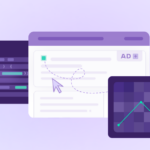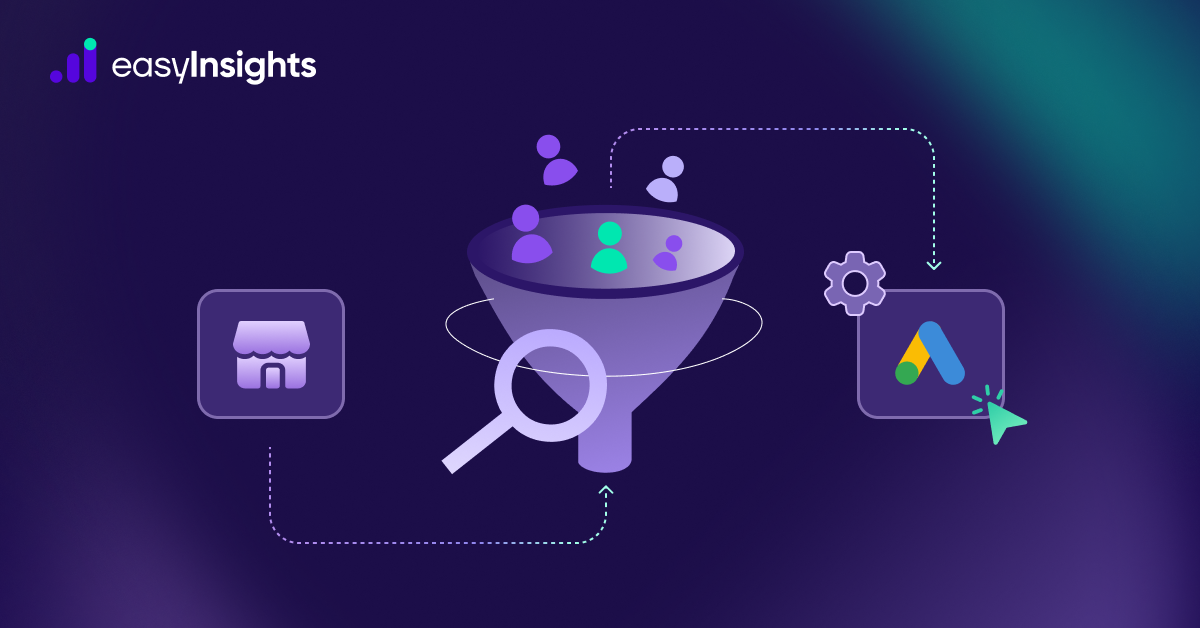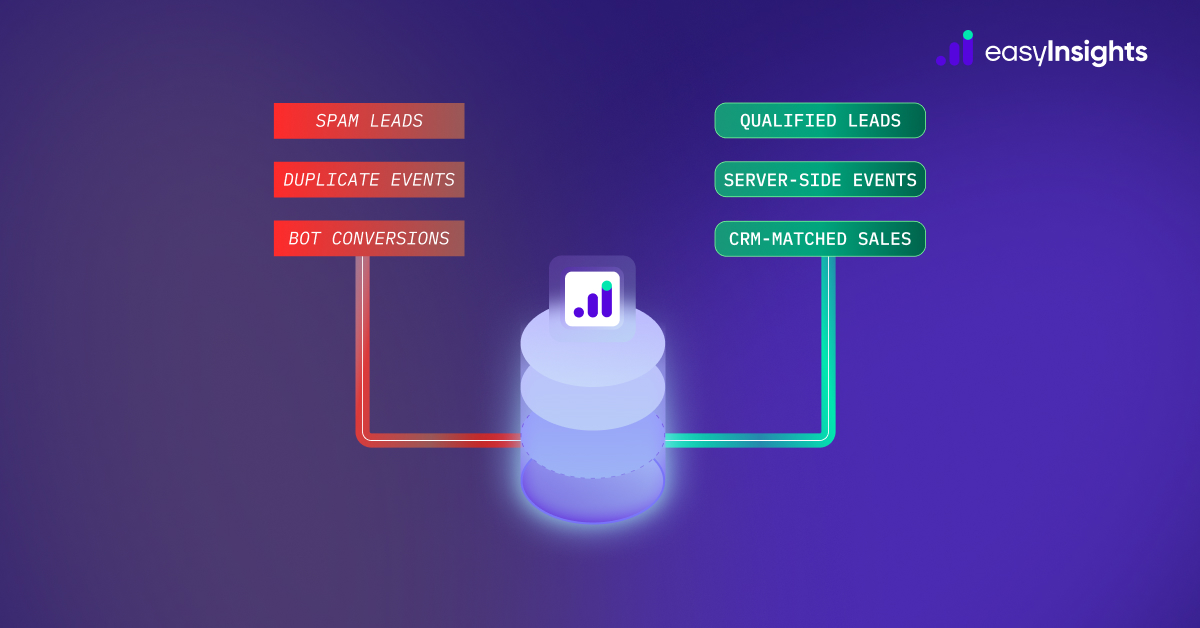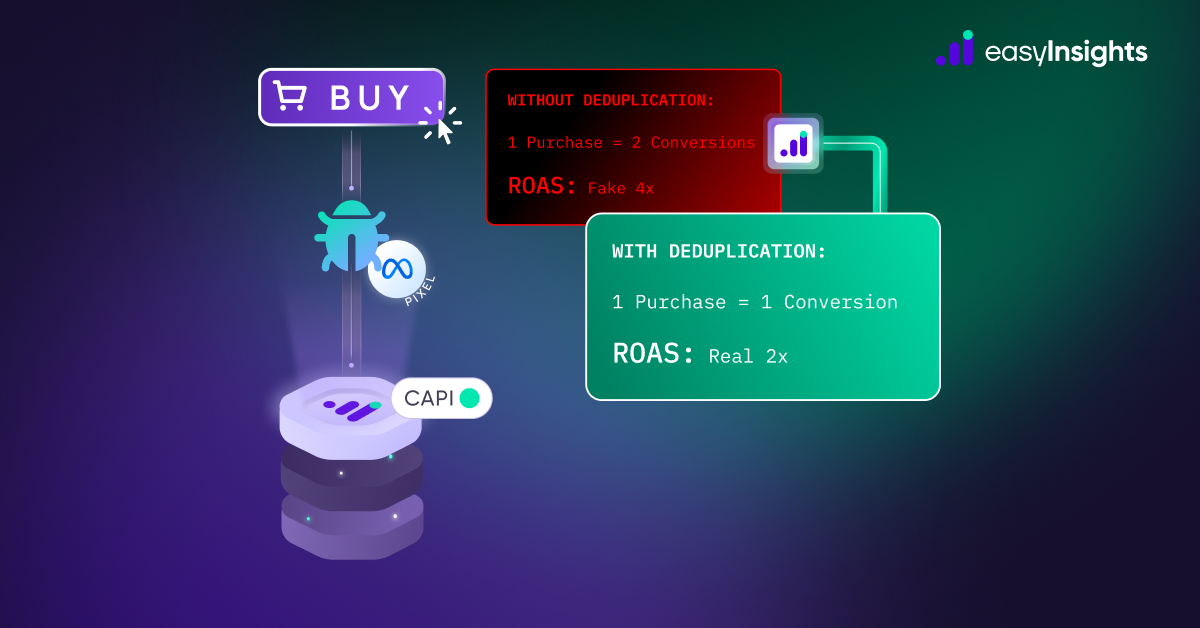
In the competitive realm of digital advertising, successful targeting is essential to optimise your return on investment (ROI). Google Ads provides robust audience segmentation tools to help you target the appropriate individuals at the most opportune moment. By grasping the various audience segments and applying effective strategies, you can greatly enhance the performance of your campaign.
In this write-up we are going to understand how audience segmentation works in Google Ads, the types of audience segments offered and how to set up Audience Segments in Google Ads.
Jump ahead to:
What Are Audience Segments in Google Ads?
Audience segments in Google Ads are defined groups of users that advertisers can target based on specific characteristics, behaviors, or interests. These segments help you show your ads to people who are more likely to be interested in your products or services – leading to better engagement, higher click-through rates (CTR), and improved return on ad spend (ROAS).
For example, if someone frequently visits home improvement websites and searches for gardening tips, they might fall under the “Home & Garden” audience segment.
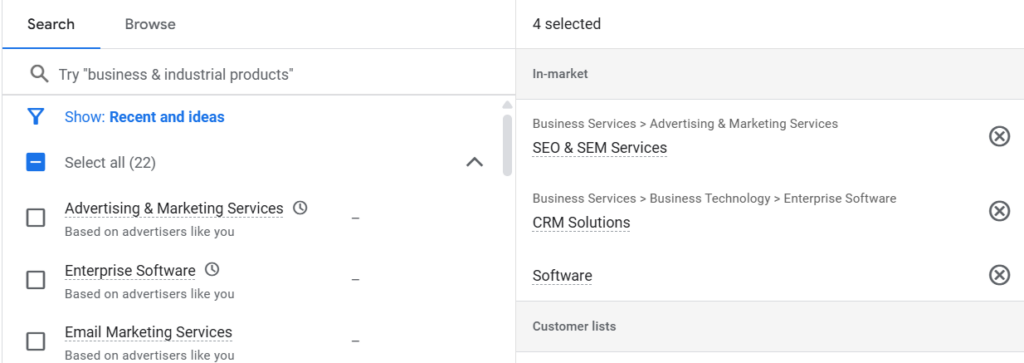
Types of Audience Segments in Google Ads
Google Ads offers several audience segmentation options to help advertisers refine their targeting:
1. Demographic Segments
Target users based on basic demographic data such as:
- Age
- Gender
- Parental status
- Household income
- Geographic location
These segments are ideal for aligning your ads with your ideal customer profile.
2. Affinity (Interest-Based) Segments
Reach people based on their long-term interests, hobbies, and habits. Google groups users into interest categories such as:
- Travel enthusiasts
- Fitness lovers
- Tech-savvy users
This type of targeting helps build brand awareness among potential customers who are likely to be interested in your niche.
3. In-Market Segments
Target users who are actively researching or comparing products/services and are likely to make a purchase soon. These users have high intent and are further down the sales funnel, making them ideal for conversion-focused campaigns.
4. Custom Segments
Create tailored audience segments using your own data sources, including:
- Keywords people search on Google
- Websites they visit
- Apps they use
You can also upload CRM data or email lists to create custom audiences unique to your business.
5. Similar Segments (Lookalike Audiences)
Reach new users who behave similarly to your existing customers or website visitors. Google uses machine learning to find these “lookalikes,” helping you expand your reach while maintaining relevance.
6. Remarketing Segments
Re-engage people who have previously interacted with your website, mobile app, or YouTube channel. Remarketing helps keep your brand top-of-mind and can significantly improve conversion rates by targeting warm audiences.
How Do Audience Segments Work?
Audience segmentation in Google Ads works by grouping users based on shared characteristics, behaviors, and intent signals – allowing advertisers to serve personalized ads to the most relevant audiences.
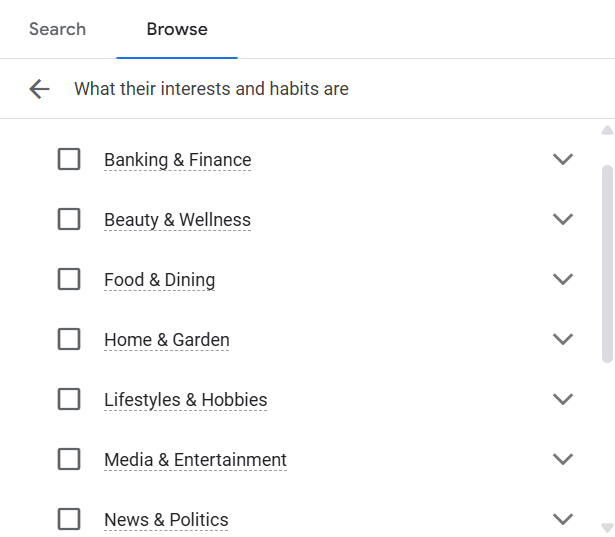
While Google offers predefined audience segments, advertisers can also create custom segments using first-party data. This is done by placing a small snippet of code—called a Google Ads tag—on your website or mobile app. This tag helps collect user behavior data such as:
- Pages viewed
- Time spent on site
- Products added to cart
- Purchases completed
Using this data, you can build remarketing lists or define custom audiences tailored to your business goals.
Where Can You Use Audience Segments?
Audience segments can be applied across multiple Google Ads campaign types:
- Search Campaigns: Show your text ads to specific segments when they search relevant keywords on Google.
- Display Campaigns: Deliver visual banner ads across Google Display Network sites to users in your selected segments.
- Video Campaigns: Target specific audiences with video ads on YouTube, appearing before, during, or after video content.
- Standard Shopping Campaigns: Show product ads to people searching for items similar to yours, with audience layering for more refined targeting.
Additional Reading: Google Ads Enhanced Conversion – All You Need to Know
Six Types of Audience Segments
Google Ads provides advertisers with six powerful audience segment types that allow you to reach the most relevant users based on interest, intent, demographics, or past behavior. Here’s a detailed look at each one:
1. Affinity Segments – Affinity segments group users based on their general interests, lifestyles, and long-term habits. Google analyzes a user’s browsing behavior, app usage, and content consumption across its platforms to categorize them.
Examples:
- Health & Fitness Enthusiasts
- Tech Savvy
- Sports Fans
- Foodies

Use Case:
A fitness brand launching a new line of protein supplements can target the “Health & Fitness” affinity segment to reach people who are most likely to be interested.
2. Detailed Demographic Segments – This type targets users based on deeper demographic data beyond age and gender. It includes lifestyle-based categories that reflect life events or characteristics.
Examples:
- Marital status (e.g., single, married)
- Parental status (e.g., parents of toddlers)
- Education level
- Homeownership status

Use Case:
A preschool brand can target “Parents of Preschoolers” to promote enrollment programs.
3. In-Market Segments – In-market audiences include people who are actively researching or considering products or services. These users have shown purchase intent, making them ideal for bottom-of-the-funnel campaigns.
Examples:
- In-market for laptops
- In-market for real estate
- In-market for travel packages
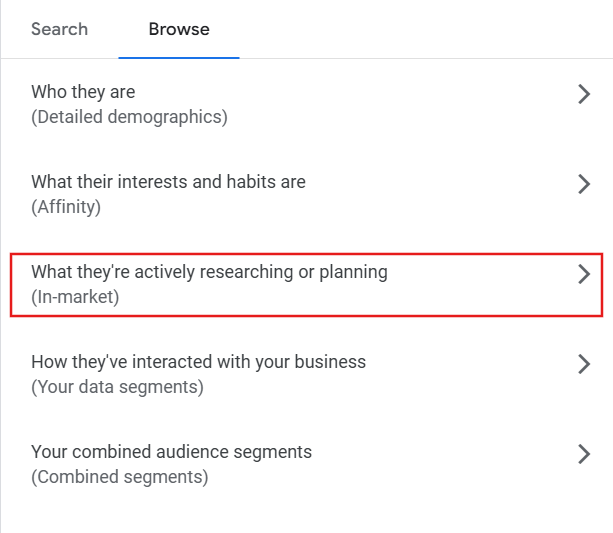
Use Case:
An electronics retailer can target users in the “In-market for Smartphones” segment during a festive sale campaign.
4. Custom Segments – Custom segments (previously called Custom Intent and Custom Affinity) allow you to define your own audience using specific keywords, URLs, and apps your target users are likely interacting with. You can also upload first-party data like email lists or CRM data.
Customization methods:
- Keywords your audience searches
- Websites they visit
- Apps they use
- Uploaded customer lists
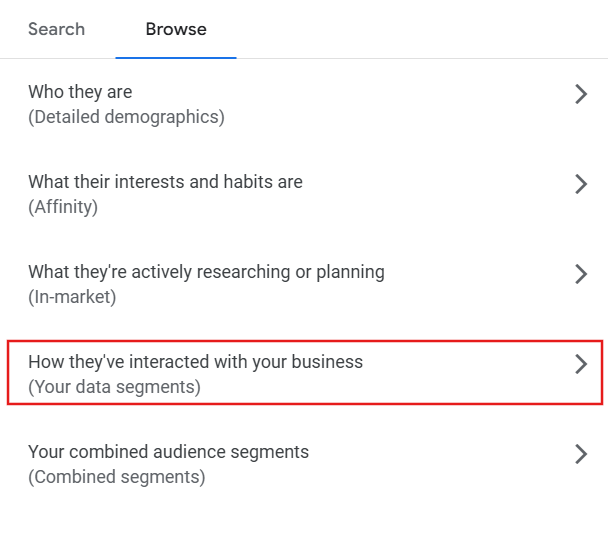
Use Case:
A SaaS tool can create a custom segment targeting people who search for “best marketing analytics tools” or visit competitor websites.
5. Lookalike Segments (Similar Audiences) – Google analyzes your existing audience (like website visitors or customers) and finds new users with similar online behavior and interests. This is an excellent way to scale campaigns while maintaining relevance.
Use Case:
An eCommerce brand can expand its reach by creating a lookalike segment based on people who previously purchased on their website.
6. Remarketing Segments – Remarketing segments target users who have previously interacted with your brand—visited your website, used your app, or watched your videos. These are warm audiences, often closer to conversion.
Types of remarketing:
- Website visitors
- App users
- YouTube viewers
- Customer list uploads
Use Case:
A fashion store can retarget users who added items to their cart but didn’t purchase—offering them a limited-time discount to complete the sale.
Setting Up Audience Segments in Google Ads
Audience segments in Google Ads allow you to target specific groups of people based on their characteristics, interests, or behaviors. This helps you deliver your ads to the most relevant audience, improving your campaign’s effectiveness.
1. Create a New Campaign or Ad Group
If you’re starting a new campaign, select the desired goal (e.g., sales, leads, website traffic). If you’re working with an existing campaign, navigate to the ad group level.
2. Choose Targeting Options
Under the “Targeting” section, select “Audiences.”
3. Creating a New Audience steps
Creating a new audience involves a series of strategic steps to ensure effective targeting and engagement. The first step is to identify the objectives of the actions, for instance, sales or visitor traffic that you desire your audiences to accomplish.
Then you should gather and analyze information about current and potential customers and market trends to identify those customers who interact with the brand. Demographic, behavioral, psychographic and geographical analysis should be used to classify the market into various segments to have a clear understanding of the target customers. Once you have your audience criteria, decide on the targeting platforms.
Click the “Create Audience” button.
4. Set a Bid Adjustment
You can adjust your bids for this audience to prioritize or deprioritize them. For example, you might increase bids for high-value customers or decrease bids for less likely converters.
5. Save and Apply
Save your audience and apply it to your campaign or ad group.
Tips for Using Audience Segments in Google Ads
- Start with Observation Mode
Use Observation for new segments to gather performance data without restricting reach. This prevents “unknown” traffic loss and helps identify high-performing audiences before investing in targeting - Layer & Combine Audiences
Combine multiple segments – like in‑market + demographics or affinity + remarketing – to reach users with both interest and purchase intent. This refines targeting, saves ad spend, and boosts ROI - Use First‑Party & Similar Audiences
Create Customer Match lists from your own data (e.g., emails, past buyers) and extend reach with Similar Audiences. Refresh these lists regularly to feed Google’s Smart Bidding with quality signals - Exclude Irrelevant Audiences
Actively exclude low-value or irrelevant groups – such as users who already converted or those in low-income brackets—to prevent wasted clicks and improve campaign efficiency - Tailor Messaging & Adjust Bids
Customize ad copy and offers for each segment (e.g., remarketing vs cold audience), and use bid adjustments to boost spend on high-performers. Monitor data and test different creatives to optimize results
Conclusion
Google Ads Audiences are must-use instruments in any advertising and marketing approach. It can help you target certain groups of consumers and then use different selling techniques in marketing that will prove effective. However, it is Beyond Remarketing that shows that Google Ads Audience Segments can be used as a very effective tool for acquiring new customers.
EasyInsights lets you collect all your marketing data from over 50+ sources under one roof, be it your CRM, advertising platform, or web and app analytics tool. You can transform this data and create unified dashboards to enable cross-platform reporting without hassle.
Not only that. You can export transformed data to any BI tool for data visualization. We can automate this entire workflow from fetching the latest data and exporting it, saving you valuable time and resources.


